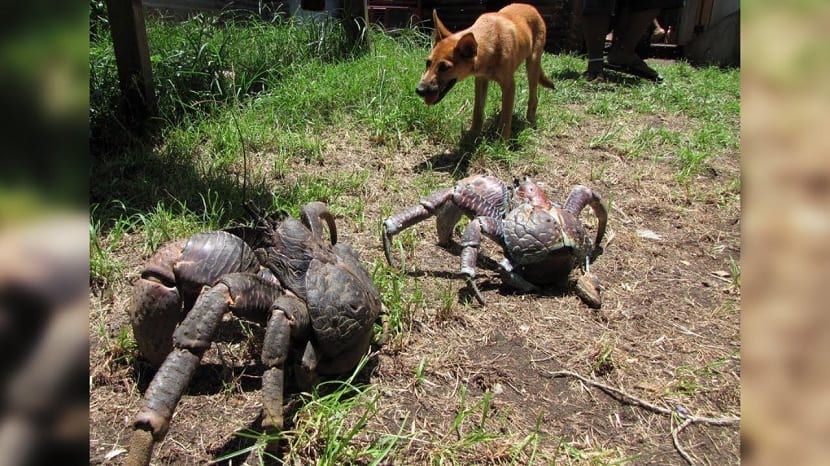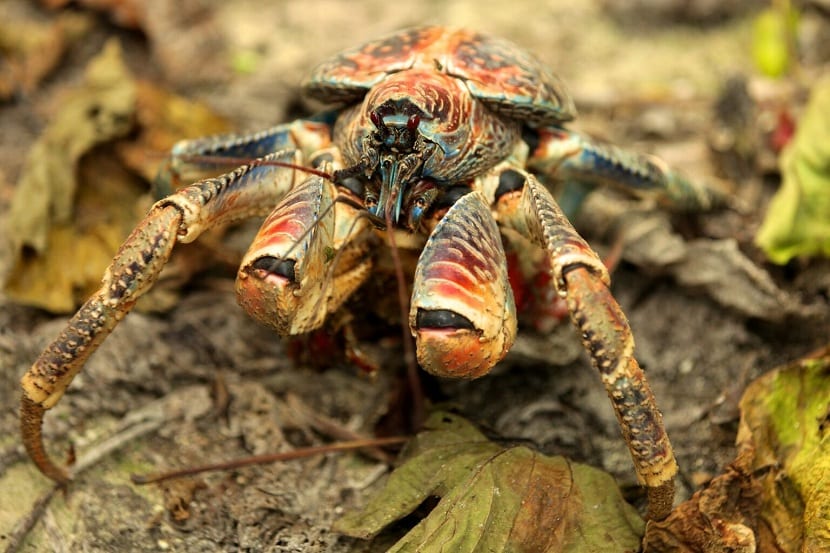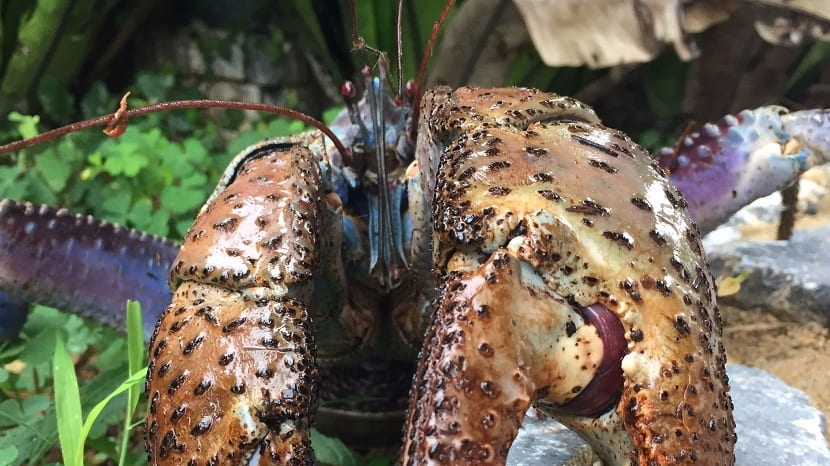
Image - Flickr / Arthur Chapman
Today we are going to talk about a species of crab known as the largest in the world. Its about coconut crab. Its scientific name is Birgus ballast. Although it is considered the largest crab in the world, this statement has some nuances. The most important nuance is that it is the largest on land since it is larger than the Japanese giant crab and the well-known spider crab. The difference from the previous one is that it lives permanently on land.
In this article we are going to delve into the characteristics, way of life, feeding and reproduction of the coconut crab.
Key features

This crab belongs to the arthropod family and is closely related to the hermit crab as discussed below. His curious measurements have caused many scientists to have described him as a true monster. The first feature that stands out the most is the enormous size. It is capable of weighing up to 4 kilos and having a maximum length of almost one meter. This makes him become the largest and scariest crab in the world.
With this enormous dimensions this crab needs large front legs dunes and fearsome claws that serve to exert crushing force on its prey. These claws have a crushing force or similar to that of many other predators that hunt by biting.
Although I have considered a type of land crab, the first beginnings in the life of this animal take place in the sea as it happens with other crabs. Coconut trees are just tiny larvae that drift through ocean currents during their first month of life. As they develop, they emerge for some time from the bottom of the sea to search for the kind of shell that can make it their mobile home. This is why I mentioned earlier that it looks a lot like the hermit crab.
This fossil killer that originates from creating its own habitat and changing from an aquatic habitat to a terrestrial one is due to a unique organ called the branchial lung that has developed throughout evolution and is halfway between the gills and lungs. As the coconut crab grows on land, it moves from one poncha to another just like the hermit crab does.
Coconut crab diet

The diet of invertebrates that are in danger of extinction is not only coconuts as one might guess. It is true that coconuts are the main part of the diet of crabs, hence their common name. In order to reach this enormous size, the coconut crab must eat almost everything. Their food needs reach such a point that they are able to turn to carrion to satisfy their needs.
They develop very slowly and do not reach reproductive maturity until they are 6 years old. But nevertheless, This is so because the life expectancy of this animal can reach 30 and 40 years.
The diet is based mainly on any type of organic matter that can be found on the road. Decaying fruits, leaves, turtle eggs, and even carcasses of other animals. This type of feeding makes it not very difficult to develop and that is why it reaches this enormous size. Scientists have been able to document that on some islands where their main food, coconut, this would be coconut crabs, they have become a type of predatory crab. This is because it is capable of attacking any other animal within its reach.
To do this, it makes use of its large claws and front legs to attack animals such as chickens, cats, rats or any other animal that it can reach with its claws. As we know, opening a coconut is not an easy task. However, these animals have no difficulty opening this hard fruit. When they find a coconut they only need to use the front pliers to tear it apart and remove all the fibrous coating.
To find food, this crab is the aid of an excellent sense of smell and its powerful antennae that serve to locate food even if it is found long distances. They usually eat at night and stay all day hiding in small stone caves or often dig their own burrows to protect themselves from other predators. The predators that are most affecting coconut crab populations are humans.
Endangered coconut crab

The populations of these animals have never been fully studied. Due to this or not it is completely known how many copies exist in total. The International Union for Conservation of Nature (IUCN) has classified it as data poor. The most recent studies reveal that the populations of these crabs have seriously declined. This decrease in populations is due to different factors such as we can find overexploitation and the lack of legislation by governments to protect these resources.
As human populations increase and domesticated animals have been incorporated into most islands, there have been changes in behavior, feeding and predation patterns in the food chain. In addition, this increase in human populations has generated a greater consumption of the coconut crab for its delicious meat. This meat is highly valued among the inhabitants of the islands and they have great socio-cultural importance.
The demand for crabs increased tremendously so populations are drastically shrinking. There is a study from 1989 that revealed that of the islands where this crab is found, an average of 24 crabs were hunted per month. As you can imagine, for a species of this type 24 copies a month is an inordinate number. This would be equivalent to an annual hunt of about 49.824 crabs that are distributed between local consumption and exports. to other areas of the world, mainly to New Zealand.
They smell knowing more about coconut crab and its context to be in danger of extinction.